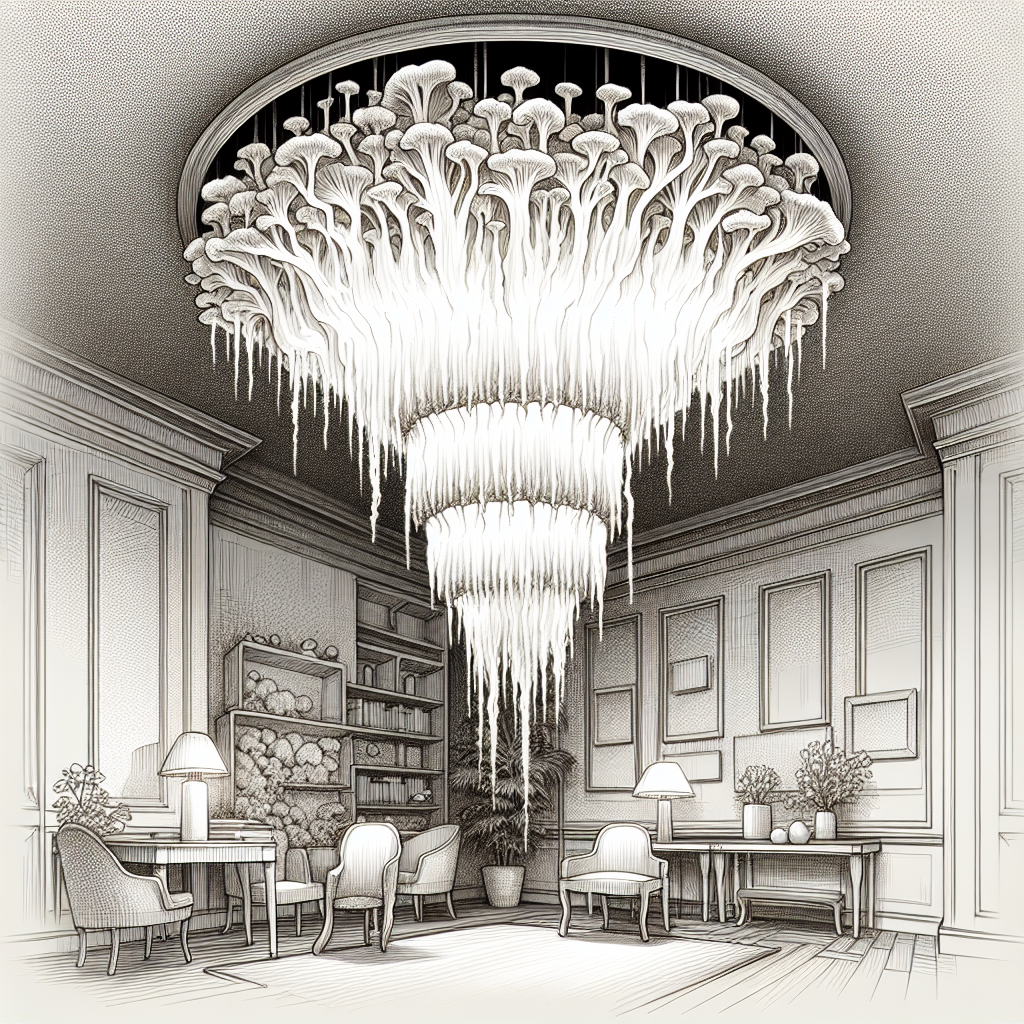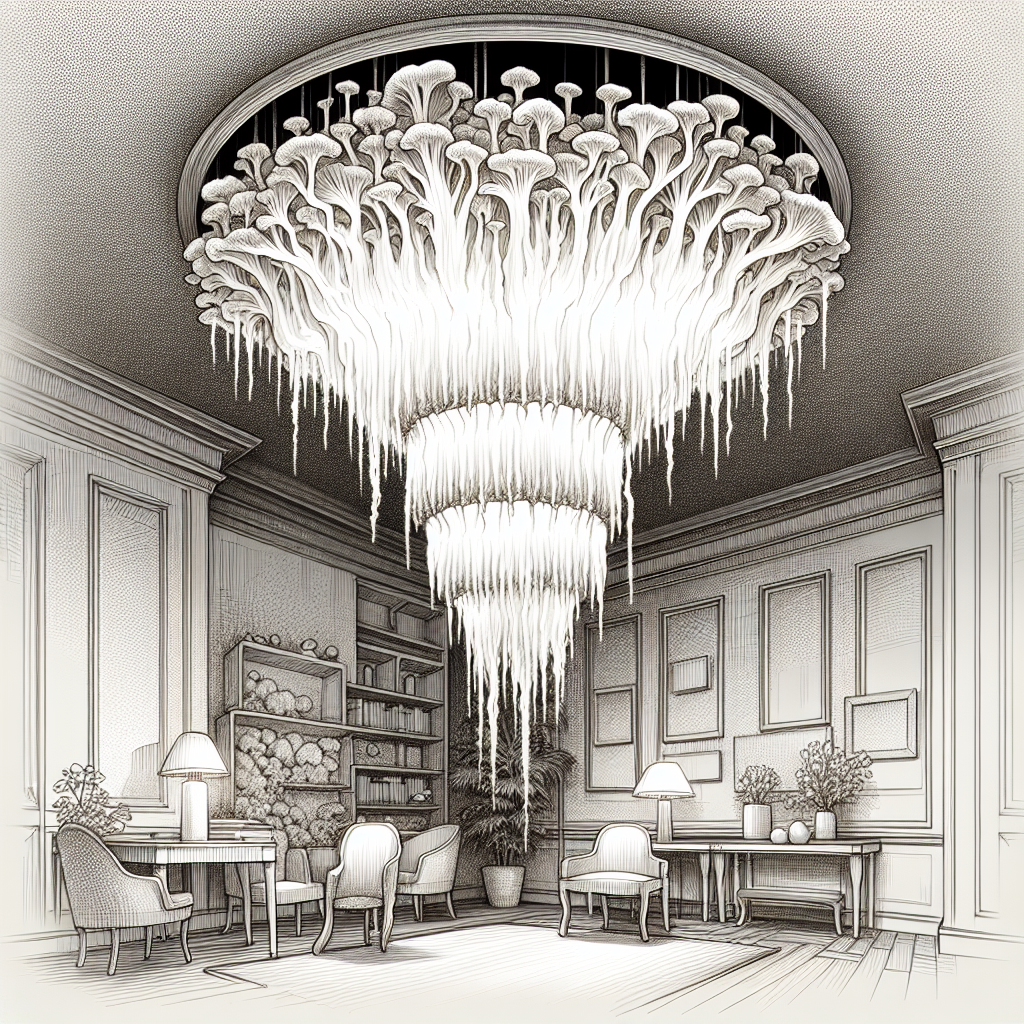In the realm of interior design and décor, it’s evident that the future calls for a more eco-conscious approach as you read through the article, “mycelium chandelier: A Step Towards Biodegradable Decor”. Focusing on the innovative Mycelium Chandelier, you’ll discover how designers are shifting towards sustainable and biodegradable materials—specifically, mycelium, the root system of mushrooms. This pioneering light fixture not only presents an elegant aesthetic, but also contributes significantly to the global push for less waste and more sustainable living environments.

What is a Mycelium Chandelier
Definition of mycelium
Mycelium is essentially a network of thread-like structures, known as hyphae, belonging to fungi. These hyphae use biochemical methods to break down organic matter. The thread-like network forms the basis of the fungi, connecting its entities and allowing it to feed, grow and reproduce.
Overview of mycelium products
Mycelium products are those made from mycelium. These can range from edible food products to architectural materials, insulation, and more recently, lighting fixtures such as the mycelium chandelier. The versatility and biodegradability of mycelium make it a popular choice in sustainability-focused applications.
Introduction to mycelium chandelier
A mycelium chandelier is an eco-friendly lighting fixture made from this mold. The lamp represents a breakthrough in sustainable decor, combining innovative biofabrication processes with an aesthetically pleasing design. Each piece is unique, organic, and 100% compostable, making this chandelier not only a beautiful addition to your house but also an exact representation of sustainable decor.
Mycelium: The Base Material
Overview of mycelium as a material
Mycelium acts as a bonding agent for organic waste products, creating a robust and biodegradable material. It has a similar texture and color to cork or leather and can be shaped into almost any form, making it an incredibly versatile material to work with.
Benefits of mycelium
mycelium’s primary benefit is its sustainability. It consumes greenhouse gases during growth and post-use it can be composted, reducing waste. The material is also fire-resistant, offering an added layer of safety. Its insulation and acoustic properties make it ideal for a variety of uses.
How mycelium is grown
mycelium is grown by providing a conducive environment to fungi. Organic waste acts as a substrate on which the mycelium can feed and grow. Over a few weeks, under controlled temperature and humidity conditions, the mycelium reproduces and spreads throughout the substrate.
Creating a Biodegradable Mycelium Chandelier
Steps to create the chandelier
Creating a mycelium chandelier involves a hands-on process involving the inoculation of mycelium into a substrate, which is then placed in a mould. This setup is kept in controlled conditions to enable the mycelium to grow and take on the form of the mold. After a few weeks, the structure is baked to halt growth and solidify the product.
Tools needed
The tools necessary include a mycelium starter (also known as spawn), organic substrate (like agricultural waste or coffee grounds), a mould for the chandelier, a large bucket or container for mixing, baking oven, and protective clothing for handling mycelium and substrate.
Precautions to take during assembly
While handling mycelium, wear protective gear such as gloves, facemasks and lab coats. Be wary of the temperatures and humidity levels when growing mycelium. Too high or too low may inhibit growth. Do not introduce external contaminants into the growth chamber, as this may affect the quality of growth.

Benefits of Biodegradable Decor
Impact on the environment
Biodegradable decor like the mycelium chandelier reduces waste in landfills, as they break down naturally. Their production requires less energy and releases fewer greenhouse gas emissions compared to their non-biodegradable counterparts.
Sustainability aspect
The production and disposal of biodegradable decor contribute positively to the circular economy, where waste is recognition as a resource rather than a burden. The adoption of such decor promotes sustainability in interior design and decor industries.
Rising trend in eco-friendly decor
Consumer consciousness about environmental sustainability has grown, driving the trend for eco-friendly alternatives in the decor industry. Biodegradable decor not only caters to this burgeoning demand but also adds a unique charm to spaces with their organic aesthetics.
Challenges in Producing Mycelium Products
Understanding the mycelium growth process
Understanding the growth parameters, such as ideal temperature, pH, and moisture levels, is crucial for successful mycelium cultivation. variations may result in subpar growth or even contamination.
Time needed for growth
Growing mycelium products takes time, ranging from weeks to months, depending on the size and complexity of the design. For commercial applications, this delayed output might not be sustainable.
Storage and maintenance
Mycelium products require storage in a dry, cool environment to maintain their integrity. High humidity or moisture can trigger the fungi to start decomposing the product or invite other molds or fungi.
Lifespan of a Mycelium Chandelier
Expected lifespan of the chandelier
A well-cared-for mycelium chandelier can last several years. Its biodegradable nature does not take away from its durability, but to extend its lifespan, it needs to be kept free of excessive moisture and direct sunlight.
Factors influencing lifespan
Factors like temperature, humidity, and exposure to light could affect the lifespan of the chandelier. Mycelium prefers a cooler, drier environment and may degrade faster under direct sunlight or high humidity.
Proper care and maintenance
Clean the chandelier lightly with a dry or slightly damp cloth. Avoid using harsh cleaning agents as they might affect the mycelium’s integrity. The chandelier needs to be kept in a dry, controlled environment to prevent any premature degradation.
Popular Mycelium Chandelier Designs
Current popular designs
Popular designs tend to gravitate towards organic, free-flowing shapes that highlight the natural aspects of the material. Each piece is unique due to the nature of the mycelium growth.
How these designs are created
The designs are created by using different molds for the mycelium to grow within. Molds can be 3D printed, constructed manually using various materials, or even shaped with natural substances like sand.
Aspects to consider while choosing a design
Consider factors like the size and suitability of the design in the intended space, the lighting effect you wish to achieve, and your personal aesthetics. The design should also consider the mycelium’s organic growth patterns.
Future of Mycelium in Interior Decor
Potential for further mycelium products
Given mycelium’s properties, it has the potential to be widely employed in creating sustainable decor, beyond just chandeliers. It can be used in making various home decor items such as lanterns, wall art, and even furniture.
Current research and advancements
Research is underway to improve mycelium’s properties, such as strength, durability, and visual appeal. Advancements in 3D printing techniques are also allowing more intricate and precise prototyping of mycelium products.
Challenges and considerations
As with any natural material, there are challenges in standardized production given the nature of organic growth. Consumer perception of biological products in their living spaces and their willingness to adapt to new methods of care and maintenance also play a significant role in the product’s success.
Comparison of Mycelium Chandelier with Regular Chandeliers
Pros and cons
Mycelium chandeliers are eco-friendly, unique, and lower in cost compared to traditional chandeliers. However, they require particular care and have a slower production process.
Cost comparison
While the cost of raw materials for mycelium chandeliers is much lower, the time and specialized knowledge needed to grow and form mycelium can add to the overall cost. However, on average, they are still more cost-effective than traditional chandeliers.
Customer and market perception
Consumers are gravitating towards sustainable and unique home decor products. However, the concept of living organisms in their living spaces can require some habituation. The design industry is excited about the potential of mycelium, although user acceptance remains to be fully gauged.
Case Studies of Mycelium Chandeliers
Examples of usage in residential spaces
Mycelium chandeliers have found their place in several homes, adding an organic aesthetic. They especially resonate with individuals seeking unique and eco-friendly home decor.
Usage in commercial areas
These chandeliers are also being embraced by businesses wanting to showcase their commitment to sustainability. You can find them in eco-resorts, organic cafes, and offices focused on green initiatives.
Feedback and customer reviews
Reviews of mycelium chandeliers tend to be positive, with customers loving the unique designs and the sustainability factor. Some cite the maintenance requirements as a drawback, while others see it as a small tradeoff for the environmental benefits and unique aesthetics these pieces offer.
